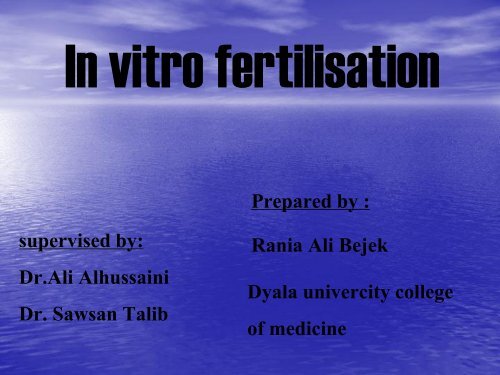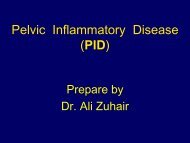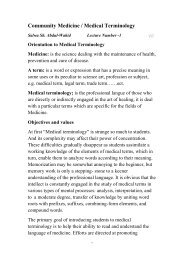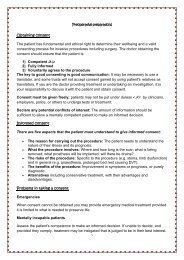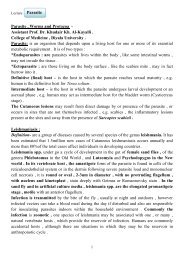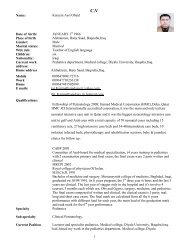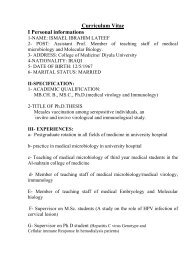In vitro fertilisation supervised by Dr.Ali Alhussaini Dr. Sausan Talib
In vitro fertilisation supervised by Dr.Ali Alhussaini Dr. Sausan Talib
In vitro fertilisation supervised by Dr.Ali Alhussaini Dr. Sausan Talib
Create successful ePaper yourself
Turn your PDF publications into a flip-book with our unique Google optimized e-Paper software.
<strong>In</strong> <strong>vitro</strong> <strong>fertilisation</strong><br />
Prepared <strong>by</strong> :<br />
<strong>supervised</strong> <strong>by</strong>:<br />
<strong>Dr</strong>.<strong>Ali</strong> <strong>Alhussaini</strong><br />
<strong>Dr</strong>. Sawsan <strong>Talib</strong><br />
Rania <strong>Ali</strong> Bejek<br />
Dyala univercity college<br />
of medicine
<strong>In</strong> <strong>vitro</strong> <strong>fertilisation</strong><br />
<strong>In</strong> <strong>vitro</strong>" <strong>fertilisation</strong> (IVF) is a process <strong>by</strong> which egg "<br />
cells are fertilised <strong>by</strong> sperm outside the woman's womb,<br />
.""in <strong>vitro</strong><br />
IVF is a major treatment in infertility when other<br />
methods of assisted reproductive technology have<br />
.failed<br />
The process involves hormonally controlling the<br />
ovulatory process, removing ova (eggs) from the<br />
woman's ovaries and letting sperm fertilise them in a<br />
fluid medium. The fertilised egg (zygote) is then<br />
transferred to the patient's uterus with the intent to<br />
.establish a successful pregnancy
<strong>In</strong>dications:<br />
1. <strong>In</strong> case of unexplained infertility when anatomy and<br />
function appear to be normal and treatable causes of<br />
infertility have been eliminated<br />
2. For patient with endometriosis<br />
3. Tubal disease<br />
4. When sperm count is low, but not so low that<br />
<strong>fertilisation</strong> is impossible.<br />
5. Patient showing evidence of cervical hostility to<br />
sperm
Ovarian stimulation<br />
Treatment cycles are typically started on the third day of<br />
menstruation and consist of a regimen of fertility medications to<br />
stimulate the development of multiple follicles of the ovaries.<br />
<strong>In</strong> most patients injectable gonadotropins (usually FSH<br />
analogues) are used under close monitoring. Such monitoring<br />
frequently checks the estradiol level and, <strong>by</strong> means of<br />
gynecologic ultrasonography, follicular growth. Typically<br />
approximately 10 days of injections will be necessary.<br />
Spontanenous ovulation during the cycle is prevented <strong>by</strong> the<br />
use of GnRH agonists or GnRH antagonists, which block the<br />
natural surge of luteinizing hormone (LH).
Ultrasound of multiple follicles in a stimulated ovary
Oocyte retrieval<br />
When follicular maturation is judged to be adequate ,human<br />
chorionic gonadotropin ( β-hCG) is given. This agent, which<br />
acts as an analogue of luteinizing hormone would cause<br />
ovulation about 36 hours after injection, but a retrieval<br />
procedure takes place just prior to that, in order to recover the<br />
egg cells from the ovary.<br />
The eggs are retrieved from the patient using a transvaginal<br />
technique involving an ultrasound-guided needle piercing<br />
the vaginal wall to reach the ovaries. Through this needle<br />
follicles can be aspirated, and the follicular fluid is handed to<br />
the IVF laboratory to identify ova. The retrieval procedure<br />
takes about 20 minutes and is usually done under conscious<br />
sedation or general anesthesia .
transvaginal technique for Oocyte retrieval
Oocyte<br />
retrieval
Fertilisation<br />
<strong>In</strong> the laboratory, the<br />
identified eggs are stripped of<br />
surrounding cells and<br />
prepared for <strong>fertilisation</strong>.<br />
<strong>In</strong> the meantime, semen is prepared for <strong>fertilisation</strong> <strong>by</strong><br />
removing inactive cells and seminal fluid. If semen is being<br />
provided <strong>by</strong> a sperm donor, it will usually have been<br />
prepared for treatment before being frozen and<br />
quarantined, and it will be thawed ready for use.
The sperm and the egg are incubated together (at a ratio of<br />
about 75,000:1) in the culture media for about 18 hours. By that<br />
time <strong>fertilisation</strong> should have taken place and the fertilised egg<br />
would show two pronuclei.<br />
The fertilized egg has 2 pronuclei .
<strong>In</strong> situations where the sperm count is low, a single sperm is<br />
injected directly into the egg using intracytoplasmic sperm<br />
injection (ICSI).
The fertilised egg is passed to a special growth medium and left<br />
for about 48 hours until the egg has reached the 6-8 cell stage .
Selection<br />
Laboratories have developed grading methods to judge oocyte<br />
and embryo quality. Typically, embryos that have reached the<br />
6-8 cell stage are transferred three days after retrieval.<br />
<strong>In</strong> many American and Australian programmes , however,<br />
embryos are placed into an extended culture system with a<br />
transfer done at the blastocyst stage, especially if many goodquality<br />
day-3 embryos are available. Blastocyst stage transfers<br />
have been shown to result in higher pregnancy rates .<br />
<strong>In</strong> Europe, day-2 transfers are common
Embryo transfer<br />
Embryos are graded <strong>by</strong> the embryologist based on the number<br />
of cells, evenness of growth and degree of fragmentation.<br />
The number to be transferred depends on :<br />
‣the number available<br />
‣the age of the woman<br />
‣other health and diagnostic factors.<br />
<strong>In</strong> countries such as the UK, Australia and New Zealand, a<br />
maximum of two embryos are transferred except in unusual<br />
circumstances.<br />
For instance, a woman over 35 may have up to three embryos<br />
transferred.<br />
This is to limit the number of multiple pregnancies.
The embryos judged to be the "best" are transferred to<br />
the patient's uterus through a thin, plastic catheter<br />
which goes through her vagina and cervix. Several<br />
embryos may be passed into the uterus to improve<br />
chances of implantation and pregnancy .
Success rates<br />
While the overall live birth rate via IVF in the U.S. is about<br />
27% per cycle (33% pregnancy rate),<br />
the chances of a successful pregnancy via IVF vary widely<br />
based on :<br />
1. the age of the woman (or, more precisely, on the age of the<br />
eggs involved) ,for women under 35, the pregnancy rate is<br />
commonly approximately 43% per cycle (36.5% live birth),<br />
while for women over 40, the rate falls drastically - to only 4%<br />
for women over 42.<br />
2. the quality of the eggs and sperm,<br />
3. the duration of the infertility,<br />
4. the health of the uterus,<br />
5. the medical expertise.<br />
It is a common practice for IVF programmes to boost the<br />
pregnancy rate <strong>by</strong> placing multiple embryos during embryo<br />
transfer. .
A recent technique is to bath an embryo in a culture of nutrients<br />
for five days until it reaches a developmental landmark known<br />
as the blastocyst stage. The doctors then determine which<br />
embryos are most likely to thrive long term.<br />
The best quality of these are transferred into a woman's uterus.<br />
<strong>In</strong> this way it is possible to enable pregnancy without the risk of<br />
multiple pregnancy. This technique is relatively new and has<br />
yet to be well tested .
There are many reasons why pregnancy may not occur<br />
following IVF and embryo transfer, including :<br />
The timing of ovulation may be misjudged, or<br />
ovulation may not be able to be predicted or may not<br />
occur<br />
Attempts to obtain eggs that develop during the<br />
monitored cycle may be unsuccessful<br />
The eggs obtained may be abnormal or may have<br />
been damaged during the retrieval process<br />
A semen specimen may not be able to be provided
Fertilisation of eggs to form embryos may not occur<br />
Cleavage or cell division of the fertilised eggs may<br />
not take place<br />
The embryo may not develop normally<br />
Implantation may not occur<br />
Equipment failure, infection and/or human error<br />
or other unforeseen and uncontrollable factors, which<br />
may result in the loss of or damage to the eggs, the<br />
semen sample and/or the embryos
The major complication of IVF is the risk of multiple births<br />
Multiple births are related to increased risk of pregnancy loss,<br />
obstetrical complications, prematurity, and neonatal morbidity<br />
with the potential for long term damage.<br />
Spontaneous splitting of embryos in the womb after transfer<br />
can occur, but this is rare and would lead to identical twins .<br />
However recent evidence suggest that singleton offspring after<br />
IVF is at higher risk for lower birth weight for unknown<br />
reasons .
Another risk of ovarian stimulation is the development of<br />
ovarian hyperstimulation syndrome<br />
If the underlying infertility is related to abnormalities in<br />
spermatogenesis, it is plausible, but too early to examine<br />
that male offspring is at higher risk for sperm<br />
abnormalities .
Birth defects :<br />
The issue of birth defects remains a controversial topic in IVF.<br />
A majority of studies do not show a significant increase after<br />
use of IVF. Some studies suggest higher rates for ICSI , while<br />
others do not support this finding.<br />
Major birth defect include chromosomal abnormalities, genetic<br />
imprinting defects, and multiple organ abnormalities.<br />
Possible explanations offered were the underlying cause of the<br />
infertility, factors associated with IVF/ICSI, culture conditions,<br />
and medications, however, the actual cause is not known .
Embryo cryopreservation<br />
If multiple embryos are generated, patients may choose to<br />
freeze embryos that are not transferred. Those embryos are<br />
placed in liquid nitrogen and can be preserved for a long time.<br />
The advantage is that patients who fail to conceive may become<br />
pregnant using such embryos without having to go through a<br />
full IVF cycle. Or, if pregnancy occurred, they could return later<br />
for another pregnancy .
Oocyte cryopreservation<br />
Cryopreservation of unfertilised mature oocytes has been<br />
successfully accomplished, e.g. in women who are likely to lose<br />
their ovarian reserve due to undergoing chemotherapy.<br />
Ovarian tissue cryopreservation<br />
Cryopreservation of ovarian tissue is of interest to women who<br />
want to preserve their reproductive function beyond the natural<br />
limit, or whose reproductive potential is threatened <strong>by</strong> cancer<br />
therapy. Research on this issue is promising .
ICSI :<br />
<strong>In</strong>tracytoplasmic sperm injection (ICSI) is a more recent<br />
development associated with IVF which allows the sperm to be<br />
directly injected in to the egg using micromanipulation.<br />
This is used :<br />
where sperm have difficulty penetrating the egg and in these<br />
cases the partner's or a donor's sperm may be used.<br />
when sperm numbers are very low.<br />
ICSI results in success rates equal to IVF <strong>fertilisation</strong> .
ZIFT :<br />
<strong>In</strong> Zygote intrafallopian transfer (ZIFT) eggs are removed from<br />
the woman, fertilised and then placed in the woman's fallopian<br />
tubes rather than the uterus .<br />
GIFT :<br />
<strong>In</strong> gamete intrafallopian transfer (GIFT) eggs are removed from<br />
the woman, and placed in one of the fallopian tubes, along with<br />
the man's sperm. This allows <strong>fertilisation</strong> to take place inside<br />
the woman's body. Therefore, this variation is actually an in<br />
vivo <strong>fertilisation</strong>, and not an in <strong>vitro</strong> <strong>fertilisation</strong>
PGD :<br />
PGD can be performed on embryos prior to the embryo<br />
transfer . A similar, but more general test has been developed<br />
called Preimplantation Genetic Haplotyping (PGH).
Ethics :<br />
•Bypassing the natural method of conception.<br />
• The creation of life in the laboratory.<br />
• Fertilization of more embryos than will be needed.<br />
• Discarding of excess embryos.<br />
• Unnatural environment for embryos.<br />
• Use of untested technology.<br />
• Not affordable for many.<br />
• Misallocation of medical resources.<br />
• Creation of embryos, then freezing them, and keeping them "in limbo".<br />
• Exposure of embryos to unnatural substances.<br />
• Destruction of embryos in research.<br />
• Potential to create embryos for medical purposes.<br />
• Potential to select embryos (PGD).<br />
• Potential to modify embryos.<br />
• Facilitation of the idea that embryos are commodities.<br />
• Financial rewards for IVF doctors dissuade them from recommending other<br />
methods to couples.<br />
• <strong>In</strong>fertility is treated as a disease and not as a symptom of underlying<br />
• medical problems.


